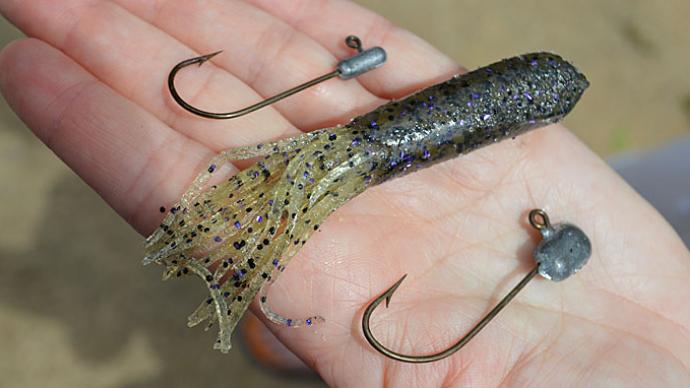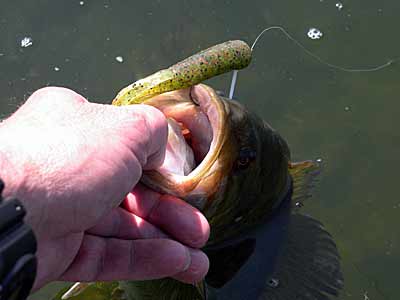
Looking at the big picture of bass fishing, you can say that it can be a niche sport at times. When you break down some of the different stages of bass fishing, specific tactics work at designated times of the year. This, in some cases, will be driven by bass locations, but other tactics are driven by traditions that have been formed throughout the years. Case in point: tube baits.
Tubes are thought of as a Springtime bait, and then many bass fishermen take their tube boxes out of the boat and don't think about them until next Spring when it gets close to spawning time again. Thinking about this these past few years, it's time to try to open up the minds of bass fishermen about tubes simply because they can catch bass all season long if given a chance.
Let’s break down tubes and look at a few different ways to rig and use tubes all season long.
Texas Rigging
Texas rigged tubes are among the most popular rigs when talking tubes, but there are a few critical differences in Texas rigging your tube. To start, put your weight onto your line as usual.
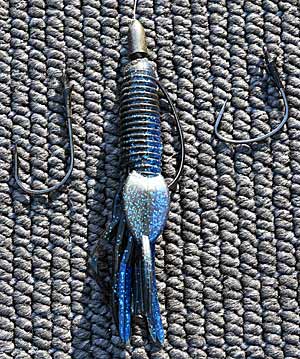
Next, what will be your hook choice? Some will use an EWG worm hook. This is ok, but as you fish, the tube will start to fall down the worm hook and may cost you a fish. To stop some of this, you can do two things. Choose a tube that has a more rigid head. What I'm trying to say is to look at the tube you're using. If the head is paper-thin, you will have difficulty keeping your tube in place on the hook. Let’s do a little tinkering.
To beef up the head of your tube, take a plastic stickbait (Senko) and cut off about a ¼” section from the middle of the bait. Put a little super glue on one end and push this up to the head of your tube. You now have a thicker head tube and will better hold onto your EWG hook. This is a good reason to save your tore-up old Senko’s.
Another way is to use an Eagle Claw tube hook with a barb keeper on a Kahle hook. The keeper will help keep your tube locked in place so it won't slip down the hook. If you have a flipping hook with a keeper, that will also work as a substitute in this situation.
One more note, I also peg my sinker in place. This keeps it from hitting against the tube head, pushing it down onto the hook.
Jig Heads
You can rig the jig inside or outside the tube when it comes to jig heads. Here is my rule of thumb on this, if I'm fishing in the weeds, I'll rig the jig inside my tube. If I'm fishing a tube on a hard bottom area outside of the weedline, I'll rig the jig head outside of the tube. The reason for this is so I can get a better feel of what the tube is doing. The jig makes better contact with the bottom and better transmits bites and bottom contact. When the jig is rigged inside, you lose a lot of the feel you would get when the jig is rigged outside the tube.
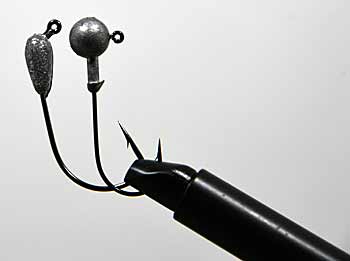
The most important part of fishing a tube with a jig head is to pay attention to the eye position. Is the eye angle of your jig at 90-degree or 60-degree? These two different eye angles on your tube jig will make your tube fall with different movements. When your jig head has a 90-degree eye angle, your tube will fall in a circle above the bass as it falls on a slackline.
Looking back to the original Fat Gitzit tube that Bobby Garland introduced to the bass world in 1983. In the original Gitzit packaging, you got four tubes and a jig head. That jig head had a 90-degree jig eye. This is what took the bass world by storm and is really what created the legend that the tube is a Springtime bait.
There is no bass alive when sitting on a bed that can't resist a tube circling above the bed over its head. It would leave the bed to meet this jig halfway down every time. It was this combination that set this whole tube thing rolling.
When I know that I'm fishing in an area where I have bass locked on beds, I'll grab a tube that is rigged with a 90-degree jig head. This will keep the jig covering a smaller area over the bass as the tube jig falls.
If you rig your tube on a jig head with a 60-degree eye angle, your tube will fall more with a gliding action when fished on a slackline. This will allow you to cover more water quicker. I'll use this tube rigging tactic when looking for signs of bass. If it's early in the Spring and I'm out trying to get bites, this is the setup I'll throw because I can cover more water when my tube hunts farther on each cast.
Stupid Tube Rigging
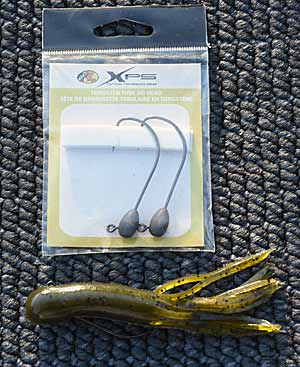
The Stupid Tube rigging is kind of like a cult thing, and for a good reason, the few guys that use this rigging catch the bass so good at times they don't want to let the cat out of the bag. So many times, they keep this rig to themselves and go their merry way, not telling a soul except their closest fishing partners that they make swear to secrecy not to tell anyone.
It takes a unique tube head that was hard to find, but now some companies offer jigs for this rigging. I generally make my tube jigs with a Do It Mold and change the hook to an EWG hook. You will need a wider gap hook to make this rigging work. Bass Pro is now offering a wider gap tube jig in its tungsten lineup. That will be an excellent place to start if you don't make your jig heads.
Rigging the Stupid tube: please watch this video so you can see it step by step instead of me trying to explain it to you. We will both be better off.
Tube Fishing Setups
I'm a fan of using both spinning and baitcasting setups. Much of my dividing point comes with the weight of the tube setup that I'm throwing and the situation that I'm fishing. For example, I'll use a spinning setup if I'm fishing in an area throwing a 1/8oz tube with a jig head rigged inside. But if I take that same setup and increase the jig size to 1/4oz, I will often change to a baitcaster setup to get a little better control of the larger bait. This is just a personal preference; I know many fishermen don't have a problem throwing a 3/8oz jig head on a spinning setup.
When it comes to fishing setups, you all know your preferences. So use your discretion in your tube bait presentation setup, either spinning or baitcaster.
Line Choices
Today’s braided lines have excelled in what you can do with a tube and still feel the bite. The typical braid-to-fluorocarbon leader lets you fish your tube with less weight and gets more natural action out of your tube but still excels in triggering bites than in the past.
I will still have a spinning rod set up in super-tough bite conditions with a choice of 8lb to 10lb Sunline Super Natural monofilament line Sunline Super Natural monofilament line choice. The reason is the floating characteristics of mono. You can slow the fall of your bait down when the bass gets turned off from either fishing pressure or weather changes. Today’s mono is not the same as it has been in the past, it has less stretch, and the feel has improved than mono in the past. Keep this tactic in your back pocket for when the bite gets super tough. It has saved the day for me on more than a few occasions.
The picture is wide open when fishing a tube, where many bass fishermen miss the point. A jig is one of the most versatile baits we have. Living in the upper Midwest, I can fish a jig from the day the ice leaves the lake until it freezes up again and have the confidence that I can catch bass.
In today’s environment, with the equipment that we have today, I think you can now put a tube in that same category. The tube is one of the most versatile tools in today’s fishing arsenal.
So, this year don't be too quick to put your tube box away after the Spring bite. Please leave it in the boat and give the tube a chance all season long. We all talk about finesse baits when the bite gets tough. I can't think of a better finesse option than a tube. Give it a try this summer. I think you will be a little surprised at the results that you get.



